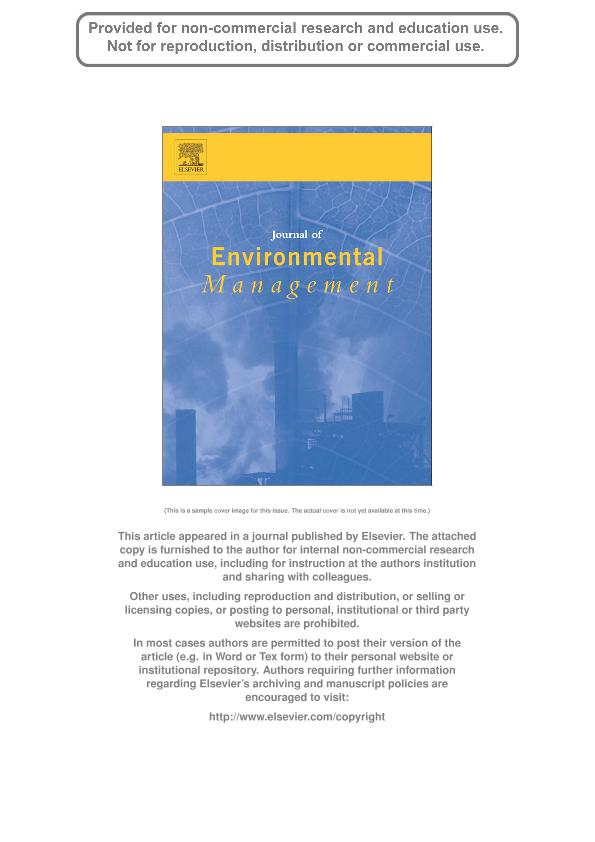Artículo
Microbiological culture broth designed from food waste
Chalon, Miriam Carolina ; Terán, Victoria
; Terán, Victoria ; Arena, Mario Eduardo
; Arena, Mario Eduardo ; Oliszewky, Ruben; Gonzalez, Silvia Nelina
; Oliszewky, Ruben; Gonzalez, Silvia Nelina
 ; Terán, Victoria
; Terán, Victoria ; Arena, Mario Eduardo
; Arena, Mario Eduardo ; Oliszewky, Ruben; Gonzalez, Silvia Nelina
; Oliszewky, Ruben; Gonzalez, Silvia Nelina
Fecha de publicación:
03/2013
Editorial:
Elsevier
Revista:
Journal of Environmental Management
ISSN:
0301-4797
Idioma:
Inglés
Tipo de recurso:
Artículo publicado
Clasificación temática:
Resumen
The current trend of increasing air, water, and soil pollution is, in part, due to inadequate management of municipal solid waste (MSW). The relationship between public health and the collection, storage and improper disposal of solid waste has encouraged several studies and the results were attributed to the spread of over twenty human and animal diseases due to this interrelationship. The term single cell protein (SCP) refers to microbial biomass used as a dietary additive. It has high nutritional value because of its high content of vitamins, lipids, and proteins of biological quality (the presence of all essential amino acids) (Lal, 2005). The aim of this work was to design a culture media for microbiological assays and to produce SCP for animal feeding, using nutrients contained in organic waste. In order to compare the effectiveness of food waste (FW) and LAPTg media, different strains of Lactobacillus, Enterococcus, Staphylococcus, Shigella, Salmonella, Saccharomyces and Schizosaccharomyces were studied. In all cases, the growth obtained from FW and LAPTg culture media were not significantly different (p > 0.05). In addition, the growth of Saccharomyces cerevisiae was studied in order to produce SCP for animal feeding. Comparative experiments involving molasses broth, FW broth, and basal broth were carried out. The biomass yield calculated at 24 h from FW broth was 13% lower than from molasses broth. The FW broth provided a significantly lower biomass yield; however, it can be very useful in areas where molasses are not available. FW broth can be elaborated at low cost, in any populated region of the world because its ingredients are wastes generated by humans. It has great versatility, allowing the development of a wide variety of microorganisms, both Gram negative and Gram positive bacteria as well as yeasts. The production of safe protein additives, with high biological quality and low cost, is necessary due to the increasing global demand for food for humans and animals.
Archivos asociados
Licencia
Identificadores
Colecciones
Articulos(CCT - NOA SUR)
Articulos de CTRO.CIENTIFICO TECNOL.CONICET - NOA SUR
Articulos de CTRO.CIENTIFICO TECNOL.CONICET - NOA SUR
Articulos(CERELA)
Articulos de CENTRO DE REFERENCIA PARA LACTOBACILOS (I)
Articulos de CENTRO DE REFERENCIA PARA LACTOBACILOS (I)
Articulos(INQUINOA)
Articulos de INST.DE QUIMICA DEL NOROESTE
Articulos de INST.DE QUIMICA DEL NOROESTE
Citación
Chalon, Miriam Carolina; Terán, Victoria; Arena, Mario Eduardo; Oliszewky, Ruben; Gonzalez, Silvia Nelina; Microbiological culture broth designed from food waste; Elsevier; Journal of Environmental Management; 115; 3-2013; 1-4
Compartir
Altmétricas



